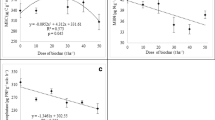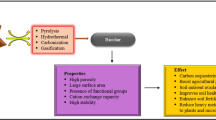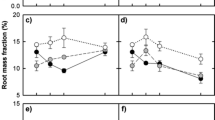Abstract
Background and aims
Biochar is known to decrease soil bulk density, increase nutrient and water retention, and to suppress certain soil-borne pathogens. The aims of our glasshouse and field experiments were to; 1) determine whether biochar amendments impact the severity of soybean root rot caused by Fusarium virguliforme; 2) to determine if biochar reduces severity of root rot by changes in physicochemical properties of soil; 3) whether biochar induces systemic resistance to root rot in soybean plants.
Results
Results of the first glasshouse pot study indicate that biochars differ significantly in their effect on root rot caused by F. virguliforme, as two of eight biochars significantly suppressed root rot severity. Results for the second glasshouse pot study indicate that disease suppression was not related to changes in soil physicochemical properties (bulk density, soil moisture, soil pH). A third split-root experiment provided no evidence that biochar amendments are capable of inducing systemic resistance in soybean plants. Results of the small plot experiment proved that biochar was effective at reducing visual above ground symptoms of SDS, but did not affect soybean grain yields.
Conclusions
Both systemic and indirect effects of biochar on SDS root rot severity have been eliminated in the present study; further research is needed to determine whether suppression of root rot severity is related to changes in soil microbial communities induced by biochar.










Similar content being viewed by others
References
Akhter A, Hage-Ahmed K, Soja G, Steinkellner S (2015) Compost and biochar alter mycorrhization, tomato root exudation, and development of Fusarium oxysporum f. sp lycopersici. Front Plant Sci 6. doi:10.3389/fpls.2015.00529
Al-Wabel MI, Al-Omran A, El-Naggar AH, Nadeem M, Usman ARA (2013) Pyrolysis temperature induced changes in characteristics and chemical composition of biochar produced from conocarpus wastes. Bioresour Technol 131:374–379
ASTM (2007) D1762–84: Standard Method for Chemical Analysis of Wood Charcoal. American Society for Testing and Materials international, West Conshohocken, PA, USA
Atkinson CJ, Fitzgerald JD, Hipps NA (2010) Potential mechanisms for achieving agricultural benefits from biochar application to temperate soils: a review. Plant Soil 337:1–18
Beckers GJM, Conrath U (2007) Priming for stress resistance: from the lab to the field. Curr Opin Plant Biol 10:425–431
Biederman LA, Harpole WS (2013) Biochar and its effects on plant productivity and nutrient cycling: a meta-analysis. GCB Bioenergy 5:202–214
Bird MI, Ascough PL, Young IM, Wood CV, Scott AC (2008) X-ray microtomographic imaging of charcoal. J Archaeol Sci 35:2698–2706
Bonanomi G, Antignani V, Capodilupo M, Scala F (2010) Identifying the characteristics of organic soil amendments that suppress soilborne plant diseases. Soil Biol Biochem 42:136–144
Bonanomi G, Ippolito F, Scala F (2015) A “black” future for plant pathology? Biochar as a new soil amendment for controlling plant diseases Journal of Plant Pathology 97:223–234
Chen CQ, Belanger RR, Benhamou N, Paulitz TC (1999) Role of salicylic acid in systemic resistance induced by Pseudomonas spp. against Pythium aphanidermatum in cucumber roots. Eur J Plant Pathol 105:477–486
Chong SK, Hildebrand KK, Luo Y, Myers O, Indorante SJ, Kazakevicius A, Russin J (2005) Mapping soybean sudden death syndrome as related to yield and soil/site properties. Soil Tillage Res 84:101–107
Coale FJ, Grove JH (1986) Alternations in soybean root development due to cultural practises. A review. Commun Soil Sci Plant Anal 17:799–818
Crossett RN, Campbell DJ, Stewart HE (1975) Compensatory growth in cereal root systems. Plant Soil 42:673–683
Dempster, D. N., Gleeson, D. B., Solaiman, Z. M., Jones, D. L., and Murphy, D. V. (2010). Biochar addition to soil changed microbial community structure and decreased microbial biomass carbon and net inorganic nitrogen mineralised. Proceedings of the 19th World Congress of Soil Science: Soil solutions for a changing world, Brisbane, Australia, 1–6 August 2010. Symposium 2.2.1 Biogeochemical interfaces in soils, 9–12
Domene X, Mattana S, Hanley K, Enders A, Lehmann J (2014) Medium-term effects of corn biochar addition on soil biota activities and functions in a temperate soil cropped to corn. Soil Biol Biochem 72:152–162
Dutta S, Mishra AK, Kumar BSD (2008) Induction of systemic resistance against fusarial wilt in pigeon pea through interaction of plant growth promoting rhizobacteria and rhizobia. Soil Biol Biochem 40:452–461
Elad Y, David DR, Harel YM, Borenshtein M, Ben Kalifa H, Silber A, Graber ER (2010) Induction of systemic resistance in plants by biochar, a soil-applied carbon sequestering agent. Phytopathology 100:913–921
Elmer WH, Pignatello JJ (2011) Effect of biochar amendments on mycorrhizal associations and fusarium crown and root rot of asparagus in replant soils. Plant Dis 95:960–966
Fernandez FG, Brouder SM, Volenec JJ, Beyrouty CA, Hoyum R (2011) Soybean shoot and root response to localized water and potassium in a split-pot study. Plant Soil 344:197–212
Fulton W, Gray M, Prahl F, Kleber M (2013) A simple technique to eliminate ethylene emissions from biochar amendment in agriculture. Agron Sustain Dev 33:469–474
Gaskin, J. W., Steiner, C., Harris, K., Das, K. C., and Bibens, B. (2008). Effect of low-temperature pyrolisis conditions on biochar for agricultural use Transactions of the Asabe 51, 2061–2069.
Graber ER, Harel YM, Kolton M, Cytryn E, Silber A, David DR, Tsechansky L, Borenshtein M, Elad Y (2010) Biochar impact on development and productivity of pepper and tomato grown in fertigated soilless media. Plant Soil 337:481–496
Graber ER, Frenkel O, Jaiswal AK, Elad Y (2014) How may biochar influence severity of diseases caused by soilborne pathogens? Cardiol Manag 5:169–183
Harel YM, Mehari ZH, Elad Y, Rav-David D, Borenstein M, Shulchani R, Graber ER (2013) Induced systemic resistance in tomato ( Solanum lycopersicum) by biochar soil amendment. IOBC/WPRS Bulletin 86:59–64
Harel, Y. M., Mehari, Z. H., Rav-David, D., and Elad, Y. (2015). Induced systemic resistance in tomato (Solanum lycopersicum) against Botrytis cinerea by biochar amendment involves jasmonic acid signaling. Plant and Soil 395:31–44
Harman GE, Howell CR, Viterbo A, Chet I, Lorito M (2004) Trichoderma species - opportunistic, avirulent plant symbionts. Nat Rev Microbiol 2:43–56
He CY, Hsiang T, Wolyn DJ (2002) Induction of systemic disease resistance and pathogen defence responses in Asparagus officinalis inoculated with nonpathogenic strains of Fusarium oxysporum. Plant Pathol 51:225–230
Hershman DE, Hendrix JW, Stuckey RE, Bachi PR, Henson G (1990) Influence of planting date and cultivar on soybean sudden-death syndrom in Kentucky. Plant Dis 74:761–766
Jaiswal AK, Elad Y, Graber ER, Frenkel O (2014) Rhizoctonia solani suppression and plant growth promotion in cucumber as affected by biochar pyrolysis temperature, feedstock and concentration. Soil Biol Biochem 69:110–118
Joseph SD, Camps-Arbestain M, Lin Y, Munroe P, Chia CH, Hook J, van Zwieten L, Kimber S, Cowie A, Singh BP, Lehmann J, Foidl N, Smernik RJ, Amonette JE (2010) An investigation into the reactions of biochar in soil. Aust J Soil Res 48:501–515
Khan J, Ooka JJ, Miller SA, Madden LV, Hoitink HAJ (2004) Systemic resistance induced by Trichoderma hamatum in cucumber against Phytophthora crown rot and leaf blight. Plant Dis 88:280–286
Kloss S, Zehetner F, Dellantonio A, Hamid R, Ottner F, Liedtke V, Schwanninger M, Gerzabek MH, Soja G (2012) Characterization of slow pyrolysis biochars: effects of feedstocks and pyrolysis temperature on biochar properties. J Environ Qual 41:990–1000
Kolb SE, Fermanich KJ, Dornbush ME (2009) Effect of charcoal quantity on microbial biomass and activity in temperate soils. Soil Sci Soc Am J 73:1173–1181
Kolton M, Harel YM, Pasternak Z, Graber ER, Elad Y, Cytryn E (2011) Impact of biochar application to soil on the root-associated bacterial community structure of fully developed greenhouse pepper plants. Appl Environ Microbiol 77:4924–4930
Laird DA, Fleming P, Davis DD, Horton R, Wang B, Karlen DL (2010) Impact of biochar amendments on the quality of a typical Midwestern agricultural soil. Geoderma 158:443–449
Lehmann J (2007) Bio-energy in the black. Front Ecol Environ 5:381–387
Lehmann J, Gaunt J, Rondon M (2006) Bio-char sequestration in terrestrial ecosystems - a review. Mitig Adapt Strateg Glob Chang 11:403–427
Li, S., Hartman, G. L., and Chen, Y. (2009). Evaluation of aggressiveness of Fusarium Vigruliforme isolates that can cause soybean sudden death syndrome Journal of Plant Pathology 91, 77–86.
Lievens B, Vaes K, Coosemans J, Ryckeboer J (2001) Systemic resistance induced in cucumber against Pythium root rot by source separated household waste and yard trimmings composts. Compost Science & Utilization 9:221–229
Luckew AS, Cianzio SR, Leandro LF (2012) Screening method for distinguishing soybean resistance to Fusarium virguliforme in resistant x resistant crosses. Crop Sci 52:2215–2223
Luo Y, Chong SK, Myers O (2001) Spatio-temporal analysis of soybean root colonization by Fusarium solani f. Sp glycines in fields. Plant Dis 85:303–310
Matsubara, Y., Li, Y., Okada, T., and Maya, M. A. (2012). Factors on induced systemic disease resistance in mycorrhizal strawberry plants. In “Acta Horticulturae” (B. Mezzetti and P. Bras de Oliveira, eds.), pp. 497–502
Morgan J (1997) Charcoal makes a fine compost. Forestry & British Timber 26:15–16
Njiti VN, Shenaut MA, Suttner RJ, Schmidt ME, Gibson PT (1998) Relationship between soybean sudden death syndrome disease measures and yield components in F-6-derived lines. Crop Sci 38:673–678
Novak JM, Busscher WJ, Laird DL, Ahmedna M, Watts DW, Niandou MAS (2009) Impact of biochar amendment on fertility of a southeastern coastal plain soil. Soil Sci 174:105–112
Ozgonen H, Karatas A (2013) Effect of salicylic acid, DL-beta-amino-n butyric acid and Acibenzolar-s-methyl + metalaxyl on mycelial growth and spore germination of Alternaria mali in vitro and on young apple seedlings. Int J Agric Biol 15:165–169
Peterson SC, Appell M, Jackson MA, Boateng AA (2013) Comparing corn Stover and switchgrass biochar: characterization and sorption properties. Journal of Agricultural Science (Toronto) 5:1–8
Pietikainen J, Kiikkila O, Fritze H (2000) Charcoal as a habitat for microbes and its effect on the microbial community of the underlying humus. Oikos 89:231–242
Robert-Seilaniantz A, Grant M, Jones JDG (2011) Hormone crosstalk in plant disease and defense: more than just jasmonate-salicylate antagonism. In “Annual Review of Phytopathology, Vol 49” (N K VanAlfen, G Bruening and J E Leach, eds) 49:317–343
Rogovska N, Laird D, Cruse RM, Trabue S, Heaton E (2012) Germination tests for assessing biochar quality. J Environ Qual 41:1014–1022
Roy KW, Rupe JC, Hershman DE, Abney TS (1997) Sudden death syndrome of soybean. Plant Dis 81:1100–1111
Rupe JC, Gbur EE, Marx DM (1991) Cultivar responce to sudden-death syndrome of soybeans. Plant Dis 75:47–50
Rutigliano FA, Romano M, Marzaioli R, Baglivo I, Baronti S, Miglietta F, Castaldi S (2014) Effect of biochar addition on soil microbial community in a wheat crop. Eur J Soil Biol 60:9–15
Sanogo S, Yang XB (2001) Relation of sand content, pH, and potassium and phosphorus nutrition to the development of sudden death syndrome in soybean. Canadian Journal of Plant Pathology-Revue Canadienne De Phytopathologie 23:174–180
Schafer K, Fabry CS, Sikora RA, Hauschild R (2006) Molecular investigations of rhizobacteria-induced systemic resistance toward the root-knot nematode Meloidogyne incognita in tomato. Bulletin OILB/SROP 29:135–140
Scherm H, Yang XB (1996) Development of sudden death syndrome of soybean in relation to soil temperature and soil water matric potential. Phytopathology 86:642–649
Scherm H, Yang XB, Lundeen P (1998) Soil variables associated with sudden death syndrome in soybean fields in Iowa. Plant Dis 82:1152–1157
Singleton PW (1983) A split-root growth system for evalusting the effect of salinity on components of the soybean Rhizobium-Japonicum symbiosis. Crop Sci 23:259–262
Spokas KA, Baker JM, Reicosky DC (2010) Ethylene: potential key for biochar amendment impacts. Plant Soil 333:443–452
Spokas KA, Novak JM, Stewart CE, Cantrell KB, Uchimiya M, DuSaire MG, Ro KS (2011) Qualitative analysis of volatile organic compounds on biochar. Chemosphere 85:869–882
Sugano S, Sugimoto T, Takatsuji H, Jiang CJ (2013) Induction of resistance to Phytophthora sojae in soyabean (Glycine max) by salicylic acid and ethylene. Plant Pathol 62:1048–1056
Thomas GW (1996) Soil pH and Soil Acidity. In: Sparks DL (ed) Methods of Soil Analysis: Chemical Methods, Soil Sci Soc of Am, Madison, WI
Vallad GE, Goodman RM (2004) Systemic acquired resistance and induced systemic resistance in conventional agriculture. Crop Sci 44:1920–1934
Vandesteene L, Clercq D d, Coosemans J, Ryckeboer J (2003) The ability of composts to induce systemic resistance against rootrot in Spathiphyllum plants. Parasitica 59:75–85
Vick CM, Chong SK, Bond JP, Russin JS (2003) Response of soybean sudden death syndrome to subsoil tillage. Plant Dis 87:629–632
Viger M, Hancock RD, Miglietta F, Taylor G (2015) More plant growth but less plant defence? First global gene expression data for plants grown in soil amended with biochar. Global Change Biology Bioenergy 7:658–672
Whipps JM (1997) Developments in the biological control of soil-borne plant pathogens. In “Advances in Botanical Research Incorporating Advances in Plant Pathology, Vol 26” (J A Callow, ed) 26:1–134
Wrather, J. A., Kendig, S. R., Anand, S. C., Niblack, T. L., and Smith, G. S. (1995). Effects of tilage, cultivar, and planting date on percentage of soybeans leaves with symptoms of sudden death syndrome Plant Disease 79, 560–562.
Xing LJ, Westphal A (2006) Interaction of Fusarium solani f. Sp glycines and Heterodera glycines in sudden death syndrome of soybean. Phytopathology 96:763–770
Zhang W, Dick WA, Hoitink HAJ (1996) Compost-induced systemic acquired resistance in cucumber to Pythium root rot and anthracnose. Phytopathology 86:1066–1070
Zhao L, Cao XD, Wang Q, Yang F, Xu S (2013) Mineral constituents profile of biochar derived from diversified waste biomasses: implications for agricultural applications. J Environ Qual 42:545–552
Zwart DC, Kim S-H (2012) Biochar amendment increases resistance to stem lesions caused by Phytophthora spp. in tree seedlings. Hortscience 47:1736–1740
Acknowledgements
Funding for this research was provided by the Iowa Soybean Association. We thank the anonymous reviewers for their constructive comments.
Author information
Authors and Affiliations
Corresponding author
Additional information
Responsible Editor: Simon Jeffery.
Electronic supplementary material
ESM 1
(DOCX 55 kb)
Rights and permissions
About this article
Cite this article
Rogovska, N., Laird, D., Leandro, L. et al. Biochar effect on severity of soybean root disease caused by Fusarium virguliforme . Plant Soil 413, 111–126 (2017). https://doi.org/10.1007/s11104-016-3086-8
Received:
Accepted:
Published:
Issue Date:
DOI: https://doi.org/10.1007/s11104-016-3086-8




